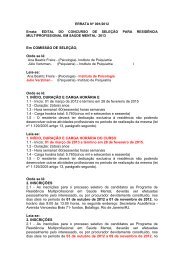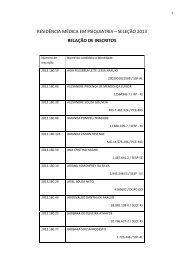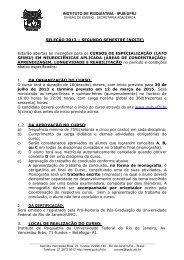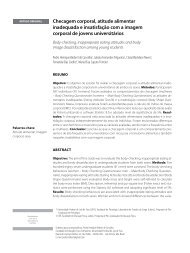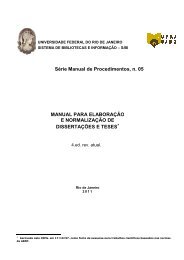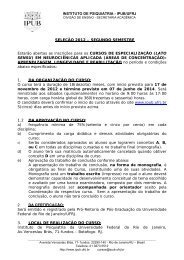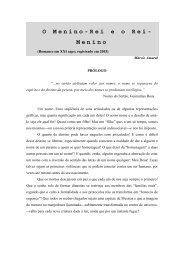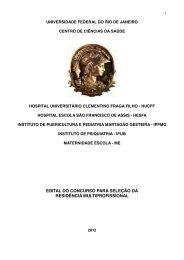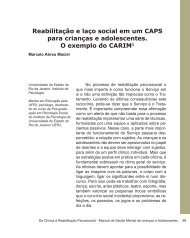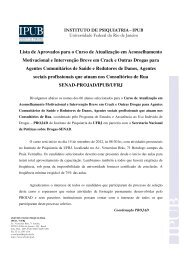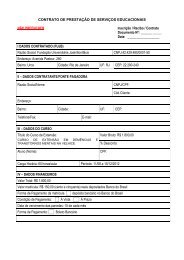Originais â Originals outubro | dezembro ⢠2011 - IPUB - UFRJ
Originais â Originals outubro | dezembro ⢠2011 - IPUB - UFRJ
Originais â Originals outubro | dezembro ⢠2011 - IPUB - UFRJ
You also want an ePaper? Increase the reach of your titles
YUMPU automatically turns print PDFs into web optimized ePapers that Google loves.
330 Maris AF, Trott A<br />
revisão de literatura<br />
29. Malzac P, Webber H, Moncla A, Graham JM, Kukolich M, Williams C, et al. Mutation analysis<br />
of UBE3A in Angelman syndrome patients. Am J Hum Genet. 1998;62(6):1353-60.<br />
30. Tilghman SM. The sins of the fathers and mothers: genomic imprinting in mammalian<br />
development. Cell. 1999;96(2):185-93.<br />
31. Sha K. A mechanistic view of genomic imprinting. Annu Rev Genomics Hum Genet.<br />
2008;9:197-216.<br />
32. Engelstadter J. Constraints on the evolution of asexual reproduction. Bioessays.<br />
2008;30(11-12):1138-50.<br />
33. Goldstone AP. Prader-Willi syndrome: advances in genetics, pathophysiology and treatment.<br />
Trends Endocrinol Metab. 2004;15(1):12-20.<br />
34. Lalande M, Calciano MA. Molecular epigenetics of Angelman syndrome. Cell Mol Life Sci.<br />
2007;64(7-8):947-60.<br />
35. Camprubi C, Coll MD, Villatoro S, Gabau E, Kamli A, Martinez MJ, et al. Imprinting center<br />
analysis in Prader-Willi and Angelman syndrome patients with typical and atypical phenotypes.<br />
Eur J Med Genet. 2007;50(1):11-20.<br />
36. Yamasaki K, Joh K, Ohta T, Masuzaki H, Ishimaru T, Mukai T, et al. Neurons but not glial cells<br />
show reciprocal imprinting of sense and antisense transcripts of Ube3a. Hum Mol Genet.<br />
2003;12(8):837-47.<br />
37. Horsthemke B, Wagstaff J. Mechanisms of imprinting of the Prader-Willi/Angelman region.<br />
Am J Med Genet A. 2008;146A(16):2041-52.<br />
38. Scheffner M, Huibregtse JM, Vierstra RD, Howley PM. The HPV-16 E6 and E6-AP complex<br />
functions as a ubiquitin-protein ligase in the ubiquitination of p53. Cell. 1993;75(3):<br />
495-505.<br />
39. Huibregtse JM, Scheffner M, Howley PM. Cloning and expression of the cDNA for E6-AP,<br />
a protein that mediates the interaction of the human papillomavirus E6 oncoprotein with<br />
p53. Mol Cell Biol. 1993;13(2):775-84.<br />
40. Weeber EJ, Jiang YH, Elgersma Y, Varga AW, Carrasquillo Y, Brown SE, et al. Derangements<br />
of hippocampal calcium/calmodulin-dependent protein kinase II in a mouse model for<br />
Angelman mental retardation syndrome. J Neurosci. 2003;23(7):2634-44.<br />
41. Wayman GA, Lee YS, Tokumitsu H, Silva A, Soderling TR. Calmodulin-kinases: modulators<br />
of neuronal development and plasticity. Neuron. 2008;59(6):914-31.<br />
42. Van Woerden GM, Harris KD, Hojjati MR, Gustin RM, Qiu S, de Avila Freire R, et al. Rescue of<br />
neurological deficits in a mouse model for Angelman syndrome by reduction of alphaCa-<br />
MKII inhibitory phosphorylation. Nat Neurosci. 2007;10(3):280-2.<br />
43. Greer PL, Hanayama R, Bloodgood BL, Mardinly AR, Lipton DM, Flavell SW, et al. The Angelman<br />
syndrome-associated ubiquitin ligase Ube3A regulates synapse development by<br />
ubiquitinating Arc. Cell. 2010;140(5):704-16.<br />
44. Tai HC, Schuman EM. Angelman syndrome: Finding the Lost Arc. Cell. 2010;140(5):608-10.<br />
45. Margolis SS, Salogiannis J, Lipton DM, Mandel-Brehm C, Wills ZP, Mardinly AR, et al. EphB-<br />
-mediated degradation of the RhoA GEF Ephexin5 relieves a developmental brake on excitatory<br />
synapse formation. Cell. 2010;143(3):442-55.<br />
46. Nakao M, Sutcliffe JS, Durtschi B, Mutirangura A, Ledbetter DH, Beaudet AL. Imprinting<br />
analysis of three genes in the Prader-Willi/Angelman region: SNRPN, E6-associated protein,<br />
and PAR-2 (D15S225E). Hum Mol Genet. 1994;3(2):309-15.<br />
47. Cattanach BM, Beechey CV. Autosomal and X-chromosome imprinting. Dev Suppl.<br />
1990:63-72.<br />
48. Salpekar A, Huntriss J, Bolton V, Monk M. The use of amplified cDNA to investigate the<br />
expression of seven imprinted genes in human oocytes and preimplantation embryos. Mol<br />
Hum Reprod. 2001;7(9):839-44.<br />
49. Rougeulle C, Glatt H, Lalande M. The Angelman syndrome candidate gene, UBE3A/E6-AP,<br />
is imprinted in brain. Nat Genet. 1997;17(1):14-5.<br />
50. Albrecht U, Sutcliffe JS, Cattanach BM, Beechey CV, Armstrong D, Eichele G, et al. Imprinted<br />
expression of the murine Angelman syndrome gene, Ube3a, in hippocampal and Purkinje<br />
neurons. Nat Genet. 1997;17(1):75-8.<br />
51. Philpot BD, Thompson CE, Franco L, Williams CA. Angelman syndrome: advancing the research<br />
frontier of neurodevelopmental disorders. J Neurodev Disord. <strong>2011</strong>;3(1):50-6.<br />
52. Dindot SV, Antalffy BA, Bhattacharjee MB, Beaudet AL. The Angelman syndrome ubiquitin<br />
ligase localizes to the synapse and nucleus, and maternal deficiency results in abnormal<br />
dendritic spine morphology. Hum Mol Genet. 2008;17(1):111-8.<br />
53. Yashiro K, Riday TT, Condon KH, Roberts AC, Bernardo DR, Prakash R, et al. Ube3a is required<br />
for experience-dependent maturation of the neocortex. Nat Neurosci. 2009;12(6):777-83.<br />
54. Zalfa F, Giorgi M, Primerano B, Moro A, Di Penta A, Reis S, et al. The fragile X syndrome<br />
protein FMRP associates with BC1 RNA and regulates the translation of specific mRNAs at<br />
synapses. Cell. 2003;112(3):317-27.<br />
55. Bassell GJ, Warren ST. Fragile X syndrome: loss of local mRNA regulation alters synaptic<br />
development and function. Neuron. 2008;60(2):201-14.<br />
56. Dictenberg JB, Swanger SA, Antar LN, Singer RH, Bassell GJ. A direct role for FMRP in activity-dependent<br />
dendritic mRNA transport links filopodial-spine morphogenesis to fragile<br />
X syndrome. Dev Cell. 2008;14(6):926-39.<br />
57. Koekkoek SK, Yamaguchi K, Milojkovic BA, Dortland BR, Ruigrok TJ, Maex R, et al. Deletion<br />
of FMR1 in Purkinje cells enhances parallel fiber LTD, enlarges spines, and attenuates cerebellar<br />
eyelid conditioning in fragile X syndrome. Neuron. 2005;47(3):339-52.<br />
58. Nimchinsky EA, Oberlander AM, Svoboda K. Abnormal development of dendritic spines in<br />
FMR1 knock-out mice. J Neurosci. 2001;21(14):5139-46.<br />
59. Comery TA, Harris JB, Willems PJ, Oostra BA, Irwin SA, Weiler IJ, et al. Abnormal dendritic<br />
spines in fragile X knockout mice: maturation and pruning deficits. Proc Natl Acad Sci U S A.<br />
1997;94(10):5401-4.<br />
60. Belichenko PV, Wright EE, Belichenko NP, Masliah E, Li HH, Mobley WC, et al. Widespread<br />
changes in dendritic and axonal morphology in Mecp2-mutant mouse models of Rett syndrome:<br />
evidence for disruption of neuronal networks. J Comp Neurol. 2009;514(3):240-58.<br />
61. Chahrour M, Zoghbi HY. The story of Rett syndrome: from clinic to neurobiology. Neuron.<br />
2007;56(3):422-37.<br />
J Bras Psiquiatr. <strong>2011</strong>;60(4):321-30.




